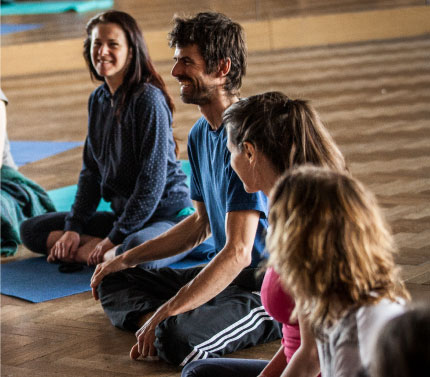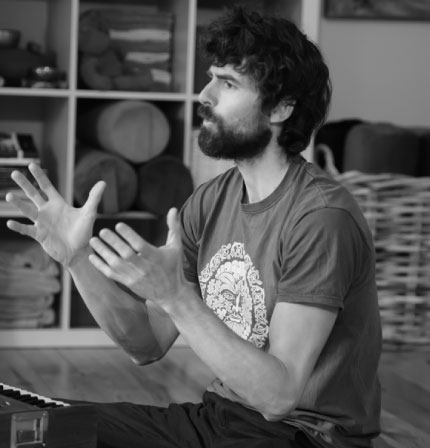
Sādhana, Sovereignty and The Ocean of Yoga Practice
Practical Yoga Philosophy and Mythology
Live online immersion June 2024
Would you like to:
- Gain deeper, more rounded and refined understanding of practical yoga principles so you can integrate them more reliably into your everyday life?
- Soak in the rich flavour and timeless supports of yogic mythology?
- Support your yoga practice and inquiry with a satsang community and classes that keep the teachings front of our awareness to help support lifelong learning?
Course timings:
6-8pm UK time Tuesdays June 4, 11, 18, 25
- All sessions are recorded so it is possible to join the course even if you cannot make the live sessions. Participants will have access to all recordings as well as additional notes.
- The 6-8pm Tuesday sessions will also be preceded by an optional 30 minute Sanskṛt recitation practice (5:30-6:00pm). During these weeks this will focus on chapter four of Patañjali’s Yoga Sūtra.
Course fees GB£108



Further Information
Sādhana, Sovereignty and The Ocean of Yoga Practice
Yoga offers us a practical, time-tested method to cultivate true sovereignty as an individual human being, a person no longer so prone to fragmentation or partiality.
The path is one of long-term commitment, over many seasons – perhaps lifetimes – of practice.
One of the tremendous beauties of the yoga tradition is the way it conveys its perennially practical and supportive teachings in different, complementary ways, from the ultra-distilled mnemonic tapestry of the yoga sūtra, the glorious, resonant poetry of the Bhagavad Gītā and rich, archetypal mythology.
In this four-week, eight hour course, we will explore the practical principles of lifelong yoga sādhana with reference to archetypal story and these mutually complementary supports.
Session overview
Session One June 4th
The royal path of yoga – aṣṭāṅga yoga is rāja yoga
With reference to the Yoga Sūtra, Rāmāyaṇa, and drawing especially from the Bhagavad Gītā, this session will introduce the broad, inclusive path of rāja yoga/aṣṭāṅga yoga and how this includes and integrates the mutually supportive paths of karma – action, jñāna – knowledge, wisdom and discernment, and bhakti – devotion and reverence for life.
Deepen your understanding of how to include your whole being in your practice, cultivate your strengths and address your weaknesses in practical, sustainable and motivating ways.
Session Two June 11th
Sādhana – Three is a magic number
Continuing the exploration of karma yoga, jñāna yoga and bhakti yoga as essential aspects of the royal path. With reference to Yoga Sūtra, Bhagavad Gītā, Rāmāyaṇa, with stories to illustrate the real nature of the yogic path and how we can infuse the practical gifts of yoga into all aspects of our lives.
Session Three June 18th
Leaping over the ocean of samsāra
Focusing on Rāmāyaṇa and Hanuman – the crest-jewel of yogis – who is great in karma, jñana and bhakti. The beautiful stories of Hanuman’s exploits and service invite us into deeper understanding of what it means to practice yoga in service of our own inner sovereign for the sake of reconciliation and lasting peace.
Session Four June 25th
Churning the Ocean of Milk Building on the previous sessions, telling and exploring the myth of the churning of the milky ocean that encodes the process of yoga practice, including key challenges and opportunities along the way.The path of yoga practice, or sādhana, is ‘intense’, challenging and sometimes intimidating. It is also empowering, revelatory and its own glorious reward.
These days however, yoga is often presented in a somewhat superficial way. Of course, yoga techniques and methodologies can be used with great efficacy to help harmonise the superficial layers of our psyche. But once the harmonisation process begins, we will be called to deeper work that can sometimes seem forbidding. However, the time-proven process of yoga fortifies us for the deepening work and its rich texts and stories offer us a reliable map and compass for this immensely rewarding journey.
This course, like all James’ online offerings, is a great opportunity to soak deeply in the teachings in clear relation to your own life and practice.
A Message From James About His Motivation for The Course
Yoga begins when we acknowledge that we are not in yoga, that we do not know ourselves as well as we might, that our perceptions are veiled and conditioned, we are not acting as freely or as fully in tune with our conscience as we might. Yoga asks us to become fully ourselves, to become fully human, and integrate our extrordinary array of animating powers and intelligence so we may access, reveal, remember our true self.
This demands an ongoing process of practice and apprenticeship. Again and again we will come to deeper recognitions of how much we have been confined in partiality, of how we have been our own enemy. Such realisations can be hard to swallow. Our contemporary society does not usually train us to digest these realisations, but often instead ushers us towards anaesthesisa, bypassing and the pit of scapegoating, blamegaming and abdication of responsibility.
The yoga teachings make it very clear that we should muster all our resources to avoid falling into this pit, and any time we realise we are in it, to forge our way out, as determinedly as possible.
One way this process is framed is as the journey to sovereignty. In Rāmāyaṇa, for example, the protagonist Rāma is the eldest child in the royal house of the Sun. His destiny then is to become established on the throne-seat-āsana of enlightenment. Rāma can be seen to represent each of us, as individual souls. His journey, his āyaṇa encodes the archetypal adventure from fragmentation and partiality to true sovereignty. In the epic, Rāma is separated from his beloved, who can be seen to represent his discernment and subtlest intelligence. She is kidnapped by the ten-headed, imbalanced mind-ego complex and sequestered in a pleasure garden, in a beautifully and strongly constructed palace, in a citadel, on an island, surrounded by the ocean – of the unconscious.
Is it not so often like this with ourselves? That our true insight and capacity remains veiled and concealed as we continue to believe in the castles we have constructed with our ego and plough on often unconsciously in directions other than those of our deepest longings and truest desires?
Rāma’s deeper integration and his proving his sovereign self comes about when the different members of the gang of his being work together in common cause to face down the cyphers of the ego-mind constructs. This brings about the reunification of Rāma and Sītā: the re-membering of the individual soul’s true capacities. This journey of coming together is what allows us to re-member who we really are and what we are really made of.
In the world we live in, there are many forces, tendencies, influences that would usher us away from the challenge of responsibility. But as Jordan Peterson has stated so clearly: ‘any responsibility you abdicate will be taken up by tyrants and used against you. This is a law of existence…’
And the voice of responsibility is always alive within us. Yoga recognises that for the human being, this gift of conscience is one of our lakṣana-s – distinguishing characteristics. We have an inner pilot light, that never goes out. It may become shrouded, it can be ignored, our connection to it can be smothered and interfered with, but ultimately it is a dharma – an essential quality of who we are as humans. Yoga invites us to incarnate all of who we are, bringing together the whole gang of our being, and reclaiming our sovereignty.
But who wants to be a sovereign? Who knows how to do that? It’s not the easiest job is it? To seek and cultivate the wellbeing of the whole and the common wealth. But Kṛṣṇa repeatedly reminds us in the Gītā that this lokasaṅgraha – wellbeing of the whole, should always be our aim. He also reminds us that our task is not to weigh ourselves against the prevailing trends and currents, but against the standards of our conscience. That while those who abdicate their real humanity will be swayed by the zeitgeist, the sovereign yogi will set a standard that elevates the zeitgeist and helps us all remember our deeper capacities for reconciliation, integration and wholeness, for clarity and equipoise even amidst the whirling wonder and tumult of life and evolving existence.
Yoga offers us a time-tested means to do this, a method that as Loren Schaumberg, who has participated in recent courses memorably describes it, has been ‘proven in the furnace of time’.
If you’d like to bring these time-proven teachings vividly into the context of your life and practice and explore them in ways so they are front of mind, I would encourage you to join my upcoming course on sādhana, sovereignty and the ocean of practice.
In this course we will integrate teachings from Rāmāyaṇa, Bhagavad Gītā, Yoga Sūtra and Purāṇa to give us a vivid and rounded understanding of the nature of the path to sovereignty, the inevitable challenges along the way and the resources and principles we have available to keep practising with enthusiasm, gratitude and purpose.
I have sometimes said that Indic Mythology is the best because it gives us such a full picture of the journey, mapping the challenges and obstacles most thoroughly; that the yogic teachings are the crest-jewel of spiritual literature because we have them in the original Sanskṛt, inviting us to ever-fresh perspectives in the context of our particular situations.
After the rich and deepening experience of the seven-month Living the Yoga Sūtra course, I am very much looking forward to sharing this June online intensive over four sessions that will weave together stories and teachings that always help orient me on the path of practice and in the ocean of life
